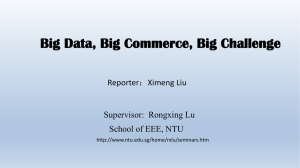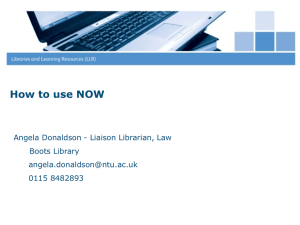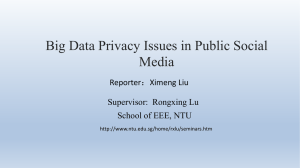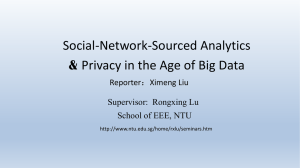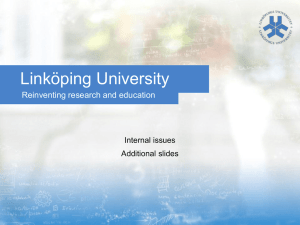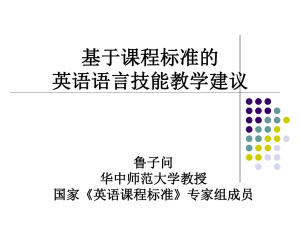Collaborative Filtering
advertisement
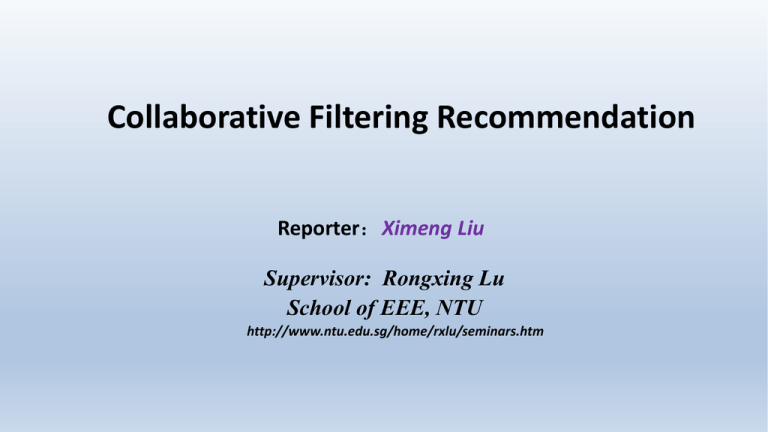
Collaborative Filtering Recommendation Reporter:Ximeng Liu Supervisor: Rongxing Lu School of EEE, NTU http://www.ntu.edu.sg/home/rxlu/seminars.htm References •1 Herlocker J L, Konstan J A, Borchers A, et al. An algorithmic framework for performing collaborative filtering[C]//Proceedings of the 22nd annual international ACM SIGIR conference on Research and development in information retrieval. ACM, 1999: 230-237. (cite:1908 ) 2. Sarwar B, Karypis G, Konstan J, et al. Item-based collaborative filtering recommendation algorithms[C]//Proceedings of the 10th international conference on World Wide Web. ACM, 2001: 285-295. (cite:3309 ) 3. Melville P, Mooney R J, Nagarajan R. Content-boosted collaborative filtering for improved recommendations[C]//AAAI/IAAI. 2002: 187-192. (cite: 850) 4. Su X, Khoshgoftaar T M. A survey of collaborative filtering techniques[J]. Advances in artificial intelligence, 2009, 2009: 4.( cite: 573) 5. Jin X, Mobasher B. Using semantic similarity to enhance item-based collaborative filtering[C]//Proceedings of The 2nd IASTED International Conference on Information and Knowledge Sharing. 2003: 1-6. http://www.ntu.edu.sg/home/rxlu/seminars.htm Liu Ximeng nbnix@qq.com Outline Collaborative Filtering based recommender user-based and item-based http://www.ntu.edu.sg/home/rxlu/seminars.htm Liu Ximeng nbnix@qq.com Collaborative filtering Collaborative Filtering (CF) is a technology that has emerged in eCommerce applications to produce personalized recommendations for users. It is based on the assumption that people who like the same things are likely to feel similarly towards other things. http://www.ntu.edu.sg/home/rxlu/seminars.htm Liu Ximeng nbnix@qq.com Collaborative filtering •Two approaches of CF based recommender; user-based or memory-based and item-based or model based. http://www.ntu.edu.sg/home/rxlu/seminars.htm Liu Ximeng nbnix@qq.com User based algorithms User based algorithms are CF algorithms that work on the assumption that each user belongs to a group of similar behaving users. The basis for the recommendation is composed by items that are liked by users. Items are recommended based on users tastes (in term of their preference on items). The algorithm considers that users who are similar (have similar attributes) will be interested on same items. http://www.ntu.edu.sg/home/rxlu/seminars.htm Liu Ximeng nbnix@qq.com Collaborative filtering Collaborative filtering algorithm is processed in item-user rating matrix. User-item matrix usually is described as a m × n ratings matrix Rmn, shown as formula (1), where row represents m users and column represents n items. The element of matrix rij means the score rated to the user i on the item j, which commonly is acquired with the rate of users’ interest http://www.ntu.edu.sg/home/rxlu/seminars.htm Liu Ximeng nbnix@qq.com User-based collaborative filtering One critical step in user-based collaborative filtering is to compute the similarity between users and then to select the nearest neighbors. There are a number of different ways to compute the similarity between users. http://www.ntu.edu.sg/home/rxlu/seminars.htm Liu Ximeng nbnix@qq.com User-based Cosine-based similarity Cosine-based similarity: In this case, two users are thought of as two vectors in the n dimensional user-space. The similarity between them is measure by computing the cosine of the angle between these two vectors. Formally, in the m × n ratings matrix, similarity between users u and v, denoted by sim(u, v) is given by http://www.ntu.edu.sg/home/rxlu/seminars.htm Liu Ximeng nbnix@qq.com User-based correlation-based similarity Correlation-based similarity: In this case, similarity between two users u and v is measured by computing the Pearson-r correlation corr(u,v). To make the correlation computation accurate we must first isolate the co-rated cases (i.e., cases where the items rated by u and v). Let the set of items which both rated by u and v are denoted by Iuv then the correlation similarity is given by http://www.ntu.edu.sg/home/rxlu/seminars.htm Liu Ximeng nbnix@qq.com User-based correlation-based similarity http://www.ntu.edu.sg/home/rxlu/seminars.htm Liu Ximeng nbnix@qq.com Predictions http://www.ntu.edu.sg/home/rxlu/seminars.htm Liu Ximeng nbnix@qq.com Item-based algorithms Item-based algorithms avoid this bottleneck by exploring the relationships between items first, rather than the relationships between users. Recommendations for users are computed by finding items that are similar to other items the user has liked. Because the relationships between items are relatively static, item-based algorithms may be able to provide the same quality as the user-based algorithms with less online computation. http://www.ntu.edu.sg/home/rxlu/seminars.htm Liu Ximeng nbnix@qq.com Cosine Similarity http://www.ntu.edu.sg/home/rxlu/seminars.htm Liu Ximeng nbnix@qq.com Correlation-based Similarity http://www.ntu.edu.sg/home/rxlu/seminars.htm Liu Ximeng nbnix@qq.com Adjusted Cosine Similarity Since different users have different rating styles. For example, in moving rating scenario, rating scale between 1 and 5, some users may give rating 5 to a lot of movies they consider to be “not bad”; while some people are “strict” raters, for they only give rating 5 to those movies they like most. To offset the different scale problem, another similarity measure called Adjusted Cosine Similarity is presented. http://www.ntu.edu.sg/home/rxlu/seminars.htm Liu Ximeng nbnix@qq.com Prediction Computation After computing the similarity between items, we select a set of most similar items to the target item and generate a predicted rating for the target item using target user’s ratings on the similar items. We use a Weighted Sum as follows. http://www.ntu.edu.sg/home/rxlu/seminars.htm Liu Ximeng nbnix@qq.com Questions & Discussion http://www.ntu.edu.sg/home/rxlu/seminars.htm Liu Ximeng nbnix@qq.com Thank you Rongxing’s Homepage: http://www.ntu.edu.sg/home/rxlu/index.htm PPT available @: http://www.ntu.edu.sg/home/rxlu/seminars.htm Ximeng’s Homepage: http://www.liuximeng.cn/ http://www.ntu.edu.sg/home/rxlu/seminars.htm Liu Ximeng nbnix@qq.com
